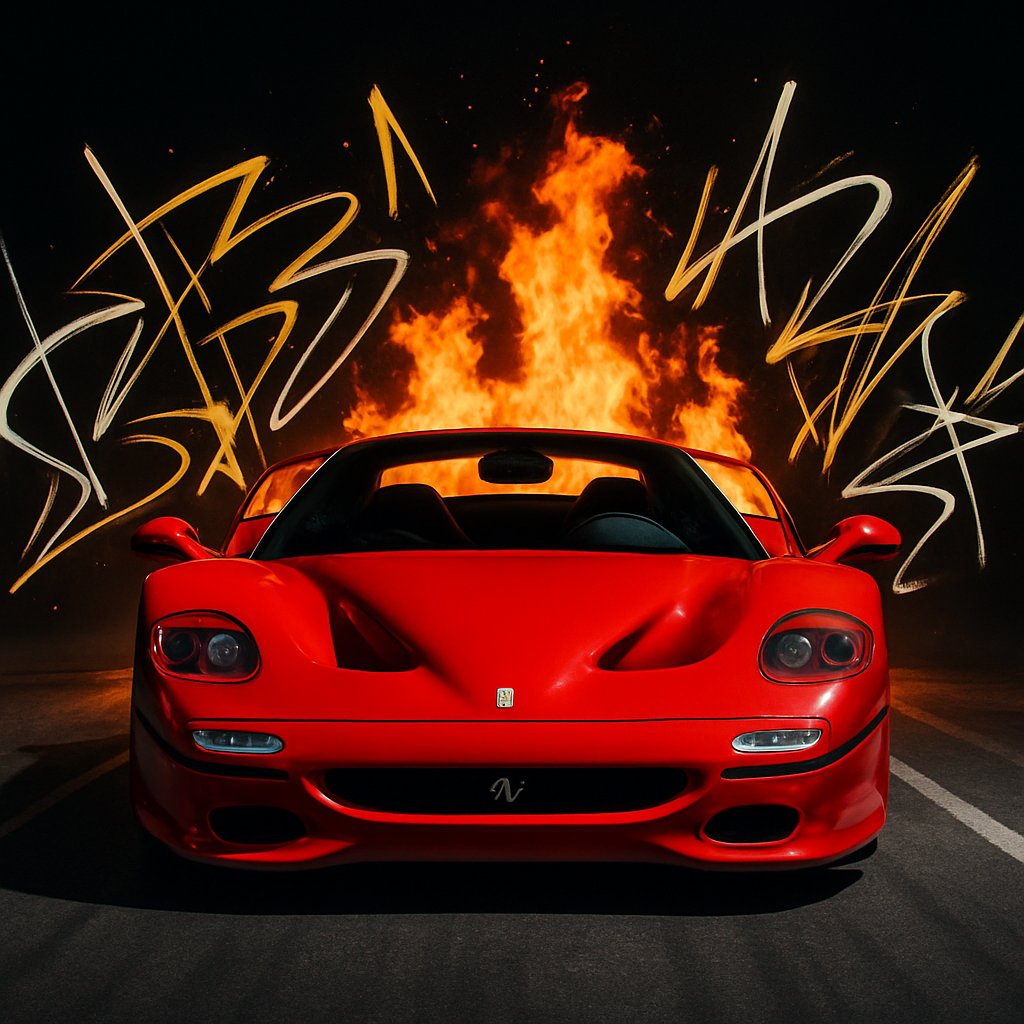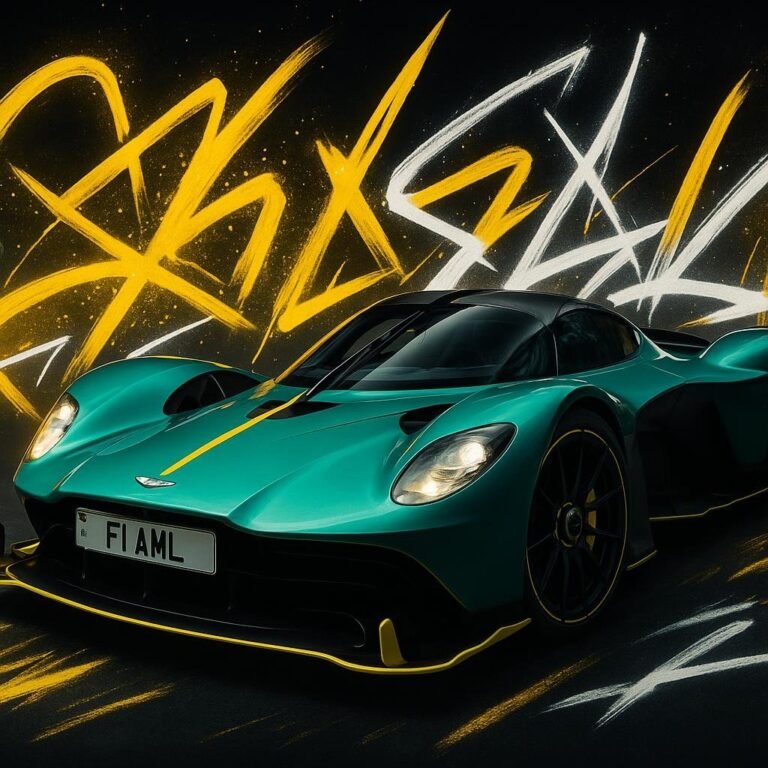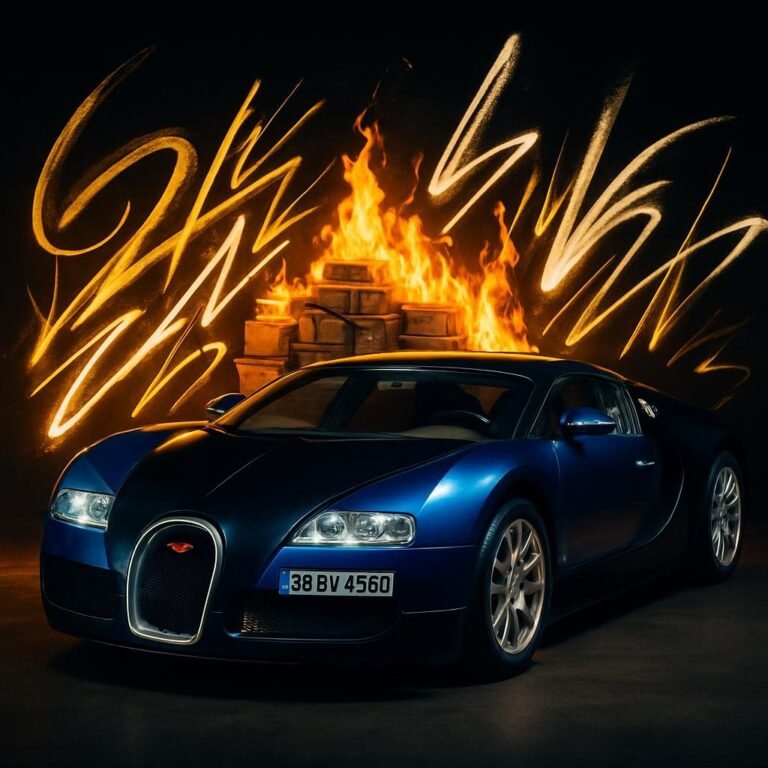The Ferrari F50 isn’t just another supercar—it’s Ferrari’s boldest attempt to shove pure Formula 1 DNA into a road-legal package. Launched in 1995 to celebrate Ferrari’s 50th anniversary, the F50 was more than a party trick; it was a living, breathing slice of F1 tech, somehow tamed for public roads.
Ferrari built just 349 of these rare machines. Each one got a naturally aspirated V12 engine, ripped straight from the heart of Ferrari’s 1990 Formula 1 car.
The F50’s development team stared down the challenge of following up the legendary Ferrari F40. But they didn’t just copy the F40’s homework—they leaned into cutting-edge aerodynamics, carbon fiber everything, and a laser focus on driver engagement.
Overview
| Specification | Details |
|---|---|
| Production Years | 1995–1997 |
| Units Built | 349 |
| Engine | 4.7L Naturally Aspirated V12 (Tipo F130B) |
| Horsepower | 513 hp @ 8,000 rpm |
| Torque | 347 lb-ft @ 6,500 rpm |
| Transmission | 6-Speed Manual |
| Drivetrain | Rear-Wheel Drive |
| Top Speed | 202 mph (325 km/h) |
| 0–60 mph | 3.8 seconds |
| Weight | 2,712 lbs (1,230 kg) |
Historical Origins and Development
The F50 sprang from Ferrari’s audacious vision: mark five decades of automotive brilliance and push the envelope on what a road car could be. They wanted to fuse their Formula 1 racing heritage with a street-legal tribute to Enzo Ferrari’s relentless spirit.
Backstory Behind the F50’s Creation
In the early 1990s, Ferrari kicked off the F50 project as the F40’s successor. They weren’t interested in repeating the F40’s turbocharged, bare-knuckle approach.
This time, Ferrari wanted to flex their naturally aspirated engine know-how. They built the F50 around Formula 1 expertise, prioritizing finesse over brute force.
By 1992, the F50 had the green light. Ferrari’s engineering team faced the tricky job of stuffing F1 technology into a road car, all while keeping performance sky-high.
Ferrari’s leadership wanted to prove that naturally aspirated engines could still deliver fireworks. That choice set the F50 apart from rivals who leaned on turbos for easy power.
It took three years of obsessive engineering and a serious investment in new materials. Ferrari wasn’t about to cut corners, not on this one.
Inspiration and Purpose of the F50
The F50 was built as a rolling tribute to Ferrari’s racing heritage. Enzo Ferrari’s philosophy—race first, then adapt for the road—drove the whole project.
They lifted the V12 engine design from the 1990 Formula 1 car, the 641, and—after some clever tweaking—dropped it into the F50 with barely any compromise.
The car debuted two years before Ferrari’s actual 50th anniversary. Ferrari wanted the F50 to headline the party, not just be another guest.
They set out to show the world that a naturally aspirated engine could outshine turbocharged rivals. The F50 became Ferrari’s love letter to their own engineering roots.
Every single part was designed for purity—no electronic nannies, no shortcuts. Just raw, unfiltered driving, the way Ferrari thought it should be.
Debut Event and Public Reaction
The Ferrari F50 broke cover at the 1995 Geneva Motor Show. Instantly, the press picked up on just how different this car felt compared to anything else.
Journalists obsessed over the F50’s F1 connection. Ferrari’s choice of a naturally aspirated V12 straight from their race cars? That got everyone talking.
The targa top shocked a lot of folks—they expected a coupe, but Ferrari went for open-air drama. That removable roof became a signature move.
Public opinion? Mixed. Some die-hards wondered if the F50 could ever match the F40’s legend, both in spirit and performance.
Ferrari capped production at 349 units right from the start. That move dialed up the exclusivity and drew in collectors, even with the eye-watering price tag.
Behind-the-Scenes Stories & World Firsts
The F50 became the first Ferrari road car to use a carbon fiber monocoque chassis. That’s pure Formula 1 tech, and it forced Ferrari to learn some new tricks.
Ferrari didn’t just bolt the engine in—they mounted it directly to the chassis. That’s a bold move, making the driver feel every pulse and vibration.
Development teams and Pininfarina spent hundreds of hours in the wind tunnel. They obsessed over every curve and vent, chasing aerodynamic perfection.
The V12 needed serious reworking to survive road use. Engineers walked a tightrope, making it reliable without dulling its F1 edge.
Ferrari built each F50 by hand in Maranello. The carbon fiber work demanded real craftsmanship—no robots, just skilled hands and sharp eyes.
Design and Engineering Team
The F50’s creation was a tag team: Ferrari’s in-house engineers handled the tech, while Pininfarina sculpted the body. Together, they dropped jaws with carbon fiber construction and F1-inspired innovations.
Key Designers and Their Roles
Ferrari’s engineers led the technical charge, determined to make the F50 the closest thing to an F1 car you could drive to the grocery store.
Ferrari Engineering kept the interior spartan, almost severe. They added an LED dashboard that felt futuristic in the ‘90s, even if it looks a bit retro now.
They ditched power steering and brake assist. That wasn’t an accident—they wanted every input to feel direct, mechanical, and honest.
With its manual six-speed, the F50 became the last limited-edition Ferrari supercar to skip paddle shifters. Later models would go digital, but the F50 kept it old school.
Engineering Innovations and Challenges
The F50 brought a bunch of world-firsts to road cars. It used an all-carbon fiber tub, straight from Formula 1’s playbook.
Key Innovations:
- Carbon fiber monocoque chassis
- Naturally aspirated, F1-derived V12 engine
- Composite materials throughout the build
Adapting F1 tech for the street? Not easy. The 3.5-liter V12 originally powered the F1-90 race car, which snagged six wins in its day.
The F50 leaned hard on F1-derived composite materials. This marked a sharp break from the old-school steel Ferrari used before.
The Role of Pininfarina in Styling
Pininfarina shaped the F50’s look, ditching the F40’s sharp edges for sensuous curves and slick aerodynamics.
The Italian design legends worked side-by-side with Ferrari’s engineers. They crafted panels that sliced the air while still turning heads on the street.
Pininfarina wanted a true spider—open-air thrills, but no loss of stiffness. The removable roof and carbon tub made it possible.
Their approach? Minimal fuss, clean lines, and just enough drama to remind you this was born from Formula 1.
Engine and Performance
| Engine Type | 4.7L DOHC 65° V12 |
|---|---|
| Power Output | 513 hp (382 kW) |
| Torque | 347 lb-ft (471 Nm) |
| Redline | 8,500 rpm |
| Induction | Naturally Aspirated |
| Top Speed | 202 mph (325 km/h) |
| Transmission | 6-Speed Manual |
The F50’s centerpiece was a 4.7-liter V12, naturally aspirated and lifted almost straight from the 1990 Ferrari Formula 1 car. With 513 horsepower on tap and a six-speed manual, it could rocket to a top speed of 202 mph.
V12 Powertrain and Formula 1 DNA

The F50’s V12 came with deep F1 roots, its design borrowed from the 641 race car. It sang to the tune of 513 horsepowerat 8,000 rpm and 347 lb-ft of torque at 6,500 rpm.
Ferrari ditched the F40’s turbo setup. Instead, the F50 went for a naturally aspirated engine, giving drivers a direct, linear punch.
They bolted the engine straight to the carbon chassis. That means you feel every vibration, every pulse—no filter, just pure connection.
To get the most out of this V12, you had to rev it out. Peak power only showed up at 8,000 rpm, so you had to work for your thrills.
Transmission and Drivetrain Details
Ferrari only offered a six-speed manual. That gearbox sat right behind the mid-mounted V12, set up transversely for a compact, balanced package.
Driving the F50 takes skill. No computers smoothed out the shifts or managed the power—every gear change was on you.
All 513 horses went to the rear wheels. At just 2,712 pounds, the F50 felt light, agile, and pretty unforgiving if you got sloppy.
Acceleration, Top Speed & Performance Specs
The F50’s numbers still impress:
| Performance Metric | Specification |
|---|---|
| 0-60 mph | 3.8 seconds |
| Top Speed | 202 mph (325 km/h) |
| Power-to-Weight | 378 hp/ton |
| Curb Weight | 2,712 lbs |
The F50 could break 202 mph, putting it in the rare 200+ mph club for its time. Quarter-mile times sat in the low 12s—not bad for a car with zero driver aids.
That naturally aspirated V12 delivered its magic in a way turbos just can’t. You had to keep the revs up, but if you did, the reward was a surge that felt almost endless.
Chassis and Suspension Technology
The Ferrari F50 rolled out as Ferrari’s first road car with a carbon fiber monocoque chassis. That move slashed weight and cranked up rigidity, leaving old-school steel frames in the dust.
Ferrari went all in with double-wishbone suspension and push-rod actuated shock absorbers, mirroring their Formula 1 setup. Handling? Razor sharp. Cornering? Rock solid, even when you’re pushing the limits.
Advanced materials like carbon fiber and Kevlar kept the F50’s chassis featherlight and tough. The tub tipped the scales at just 225 pounds—yeah, that’s it—while still ticking every safety box.
Ventilated disc brakes on all four corners gave you the stopping power you’d expect from a car with a howling V12. The light construction trimmed braking distances, making the F50 feel nimble and alive through tight sections.
Exterior, Interior, and Aerodynamics

The Ferrari F50’s look? Honestly, it’s a punchy break from the usual supercar crowd. Pininfarina penned an aggressive but somehow still graceful shape, all centered around real aerodynamic function. Inside, Ferrari ditched luxury for pure race-inspired minimalism. Everything about this car screams Formula 1 roots.
Exterior Styling and Distinctive Features

Pininfarina gave the F50 a targa-top setup, which honestly feels like the best of both worlds. Snap off those carbon fiber roof panels and you get open-air thrills without losing rigidity.
The stance? Low, wide, and ready to pounce. Sweeping curves guide air perfectly, and those massive side intakes? They’re not just for show—they’re feeding the mid-mounted V12 and keeping things cool under pressure.
Key exterior elements included:
- Rear wing seamlessly molded into the body
- Engine bay on display under a see-through cover (because why hide it?)
- Front splitter and side skirts that mean business
- Functional vents everywhere you look
The F50’s proportions make its mid-engine setup obvious. Short nose, stretched rear—just standing still, it looks like it’s itching to launch.
Ferrari stuck with carbon fiber and Kevlar for strength without the weight penalty. That decision paid off big time in performance.
Interior Design Philosophy

Step inside and you’ll see the F50’s cabin is all business. Exposed carbon fiber is everywhere, giving off a raw, industrial vibe—no frills, just focus.
Those racing buckets? They hold you tight, especially when you’re really hustling. Padding is minimal, and the side bolsters? Aggressive, to say the least.
The dash is all about the driver. Controls cluster around the wheel, so everything’s within easy reach when things get fast. Analog gauges keep you in the loop on revs, speed, and temps—no digital distractions here.
Interior highlights:
- Six-speed manual with exposed linkage—mechanical art
- Door panels stripped to the essentials, just pull straps
- Carbon fiber pedals and shifter
- No radio, no AC, no power toys—just the basics
Ferrari didn’t bother with much sound deadening. They wanted you to hear the engine, the gears, the road—every mechanical detail. It’s loud, it’s raw, and honestly, it’s kind of magical.
Aerodynamic Innovations
Ferrari’s aerodynamic know-how took center stage during the F50’s development. They leaned on Formula 1 experience to nail downforce and cooling.
The integrated rear wing adds serious downforce at speed, but it’s so well blended you hardly notice it’s there. Clean lines, proper function—classic Ferrari.
Underneath, sculpted panels speed up airflow and create suction, pinning the car to the tarmac. It’s like the F50 is glued to the road at speed.
Aerodynamic features:
- Front air dam channels wind under and around the car
- Side intakes double as both cooling and aerodynamic aids
- Rear diffuser manages air exit for extra stability
- Smooth underbody panels to keep drag low
Cooling ducts everywhere keep the engine, brakes, and transmission from overheating. These aren’t just functional—they’re part of the F50’s unmistakable look.
Ferrari spent ages in the wind tunnel getting every detail right. The result? Downforce and drag in perfect balance, so the F50 stays stable even at wild speeds.
Driving Experience, Reviews, and Ownership
Driving the Ferrari F50 feels like nothing else. That Formula 1-derived V12 is the beating heart, giving you a direct, almost primal link to the car. Early on, some folks thought it was too raw, but now? Most agree it’s a pure, analog legend.
Impressions from Test Drives and Media
The F50’s driving experience splits opinion. Some love its wild side; others think it’s too hardcore. The naturally aspirated V12 kicks out 512 horsepower, launching you to 60 mph in about 3.8 seconds.
Pro drivers rave about the steering and feedback. That carbon fiber tub? It sends every bump and shudder right up your spine—you feel everything.
The six-speed manual needs a deliberate hand. The clutch is old-school heavy, so don’t expect city traffic to be a breeze.
Pop off the targa roof and the F1 soundtrack floods in. It’s immersive, and honestly, most new supercars can’t touch that sensation.
The F50 doesn’t flatter sloppy driving—it demands focus. But nail it, and the rewards are off the charts.
Owner Community and Demographics
F50 owners are a rare breed—usually serious collectors with deep pockets and a love for analog supercars. With just 349 built, it’s an exclusive club.
Most owners have a thing for Ferrari’s racing roots and historical significance. These aren’t first-time buyers—they’re folks who know what they’re getting into.
The F50 community is tight-knit and passionate. Owners show up at private Ferrari events and track days, sharing stories and swapping tips.
Values shot up in the 2010s, so some bought in as investments. Early adopters who held on have seen their patience pay off big-time.
It’s not a car for the faint-hearted or casual supercar shopper. The F50 is demanding, and that’s exactly why its fans love it.
Notable Quotes from Designers and Journalists
Ferrari’s engineers built the F50 to be “the closest thing to a roadgoing F1 car Ferrari has ever created”. That idea drove every decision, from engine to chassis.
One Ferrari expert once said a neglected F50 could cost $150,000 just to bring back to life. These cars need to be driven—not left to gather dust.
Back in the day, critics thought the F50 was too harsh next to the F40. Now? That rawness is what sets it apart.
Racing journalists call the F50’s V12 “one of the purest V-12 driving experiences in the world.” The sound alone is unforgettable—part symphony, part thunderstorm.
Ownership Costs and Maintenance
Owning an F50 is not for the faint of wallet. Annual upkeep can easily hit $25,000 to $50,000 if you want things done right.
The fuel bladder needs swapping every decade, and digital dash bits plus trick suspension parts can be trouble spots.
Major Service Items:
- Engine: $15,000-30,000 a year
- Transmission: $5,000-10,000
- Fuel bladder: $8,000-12,000
- Carbon fiber checks: $3,000-5,000
Letting an F50 sit is a recipe for headaches—dried seals, bad tires, gummed-up fuel systems. Regular use is the secret to keeping it happy.
Insurance costs match the F50’s sky-high value—think $2.5 to $4.5 million. Add a few grand more for climate-controlled storage, and you get the picture.
Legacy, Variants, and Market Value
The Ferrari F50’s legacy? It’s way bigger than its 349-unit run. This car is a true icon—part race car, part investment, and all heart. Its performance and rarity have sent values soaring in recent years.
F50 GT and Other Special Editions
The crown jewel among variants is the Ferrari F50 GT. Built in the late ‘90s, only three ever left the factory, making it one of the rarest Ferraris out there.
The F50 GT got wild aero upgrades: massive rear wing, deep front splitter, and gnarly side intakes. Its engine pumped out about 750 horsepower, a huge jump over the standard 520.
Key F50 GT Specifications:
| Specification | Details |
|---|---|
| Power | 750 hp (560 kW) |
| Weight | 200 lbs lighter than F50 |
| Transmission | Sequential 6-speed |
| Top Speed | Over 235 mph (estimated) |
| Production | 3 prototypes only |
Ferrari kept the regular F50 unchanged during its run—no endless variants like later models. That purity helps make it a collector’s dream today.
Lap Records, Awards, and Achievements
The F50 hit some wild numbers for its day. Top speed? 202 mph. 0-60 mph? Around 3.7 seconds.
Pro racers loved its F1-inspired handling. The naturally aspirated V12 gave instant response—no waiting for turbos to spool up.
Notable Performance Achievements:
- Top Speed: 202 mph
- 0-60 mph: 3.7 seconds
- Quarter Mile: 11.8 seconds
- Nürburgring: Lap times that kept rivals honest
The F50’s carbon chassis laid the groundwork for future Ferrari tech. That tub design became the template for the next wave of limited-run Ferraris.
Competitor Cars of the 1990s
The F50 had some heavy-hitting rivals in the ‘90s. The McLaren F1 was the headline act, with its 240 mph top speed and wild central seat.
Lamborghini’s Diablo was another contender—similar performance, lower price, and that unmistakable Italian flair. It was hard to ignore.
Primary Competitors:
| Model | Engine | Power | Top Speed | Price (New) |
|---|---|---|---|---|
| McLaren F1 | 6.1L V12 | 627 hp | 240 mph | $815,000 |
| Porsche 911 GT1 | 3.2L Twin-Turbo Flat-6 | 600 hp | 191 mph | $900,000 |
| Lamborghini Diablo VT | 5.7L V12 | 492 hp | 202 mph | $239,000 |
| Jaguar XJ220 | 3.5L Twin-Turbo V6 | 542 hp | 217 mph | $650,000 |
The older Ferrari F40 still had a cult following. Many purists saw it as even more focused and raw than the F50—though, honestly, both have their own unique magic.
Brand Impact, Value Appreciation, and Collector Importance
The Ferrari F50’s market value? It’s absolutely skyrocketed in the last decade. Back in the early 2000s, you could snag one for around $400,000—now, pristine examples are hammering down at auction for $3-5 million. That’s not just inflation talking; that’s pure, unfiltered passion for a rare machine.
Why the surge? Well, folks are waking up to the F50’s place in history. This car stands as the last naturally aspirated Ferrari supercar before turbochargers and batteries started creeping in. There’s something a little poetic about that, isn’t there?
Value Timeline:
- 1995 Launch: $475,000 MSRP
- 2005: $350,000-400,000 market value
- 2015: $1.5-2.5 million range
- 2025: $3-5 million for pristine examples
Collectors can’t resist the Formula 1 heritage that pulses through the Ferrari F50. The 4.7-liter V12 engine, derived straight from Ferrari’s 1990 F1 car, gives it a pedigree that’s tough to match. You hear that engine wail, and suddenly, you’re not just driving—you’re living out a motorsport fantasy.
And let’s talk rarity. Ferrari built just 349 F50s for the entire planet. Compare that to the 1,311 Ferrari F40s out there—suddenly, the F50 feels almost mythical. If you spot one in the wild, it’s a bit like seeing a unicorn on your morning commute.
Final Words
Owning an F50 means more than speed—it’s a passport to Ferrari’s racing DNA. Every detail, from the naturally aspirated V12 to the carbon fiber tub, screams precision and passion. With only 349 made, this isn’t a supercar—it’s a legend. Rare, demanding, and intoxicating, the F50 rewards skill, patience, and a love for pure, analog thrills.
Thanks for reading! If you enjoyed this deep dive, be sure to subscribe to my email list for exclusive car reviews, insider tips, and weekly special offers on car parts, auctions, and gear — perfect for any car enthusiast.
If you have any thoughts or experiences with this car? Leave a comment below — I love hearing your opinions and sparking conversations with fellow enthusiasts.
And don’t forget to read related posts for more great content!





[…] Nostalgia Factor really can’t be overstated when it comes to cars that failed but are now collectibles. Adults who grew up dreaming about these cars finally get to buy them, sometimes just for the thrill. […]